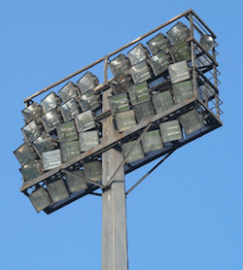I recently stumbled across the following article about a floodlit game in the sports magazine „Freie Sport-Woche. Zeitschrift für Spiel und Sport“ from 1930:
Football at night?
In England the first football match has been played under artificial lighting; opinions about it differ in the English daily and sports press. The socialist organ, the Daily Herald, comments:
„Seductive as the idea of night football is, however, it is doubtful whether it has any practical value. As a temporary sensation it may capture the imagination of the masses, but as a permanent fixture the night football game is unlikely to hold its own. Football is a game for broad daylight; much of its appeal will disappear when it is played in the light of arc lamps; it will become an artificial game under artificial lighting. Then football will also be a sport for the winter. Football at night, however, in order to be financially profitable, would have to be played throughout the summer and would thus compete with summer sports. The fresh air of the winter day actually gives the football player life and strength in the first place; he runs and kicks himself warm, and that which would refresh him in the winter cold would be stifling in the summer heat. Night football in winter, however, is unthinkable. In the afternoon, the masses like to watch the game and get excited about a beautiful sport. But the number of those who go to the football pitch on cold winter evenings to watch two teams warming up, freezing themselves, is probably very small.
Würth.
(Source: „Freie Sport-Woche. Zeitschrift für Spiel und Sport“. 12 (1930). P. 306 (= number 16, 22 April 1930).)
The first floodlit game did not take place in England until 1930?
Spoiler: No, it didn’t, but as early as 1878 in Sheffield, specifically on 14 October 1878 at Bramall Lane, now the home ground of Sheffield United, between 6pm and 7pm local time. It is said that in addition to the 12,000 paying spectators, at least 8,000 others scrambled over the boundary walls in the darkness unnoticed.
John Tasker of Sheffield fixed four arc lamps to four wooden towers, a good nine metres high, one near each corner of the football pitch. The arc lamps were powered by two steam-driven engines, one behind each football goal. The brightness of the light is said to have reached 8,000 candlepower – which is also approximately 8,000 lux.
John Tasker was a trained shoemaker and thus well versed in the rubber and leather industry. He was fascinated by the possibilities that electricity offered, and especially by his knowledge of non-conductive rubber in the insulation of electric cables. He also opened Sheffield’s first telephone exchange, first electric power station, first electric supply network – and just the first floodlight. Ladies wore parasols, the fashionable sunshades of the time, which they actually used against the midday sun. Apparently they feared that electric light would also tan their complexions.
Technology with a future
Football matches with electric light was a win-win situation for football clubs and for electricity companies, for the companies it brought awareness of their business and the value of electricity that could be widely used, for the clubs the opportunity to increase attention and thus income. But after a few floodlit games, the obvious problems came to the fore: the height of the lamps, the brightness (most games were played with only two lamps), the fluctuating voltage of the electricity and the finite amount of power the generators could produce, which usually did not last until the final whistle.
In 1888, there was another attempt with Wells Lights – a paraffin burner, but it produced far less than half the brightness of electric lamps. But even this method had its problems. In 1930, there was apparently another floodlighting attempt, but this probably led to problems again.
Floodlit matches have only been held regularly since the late 1950s.

